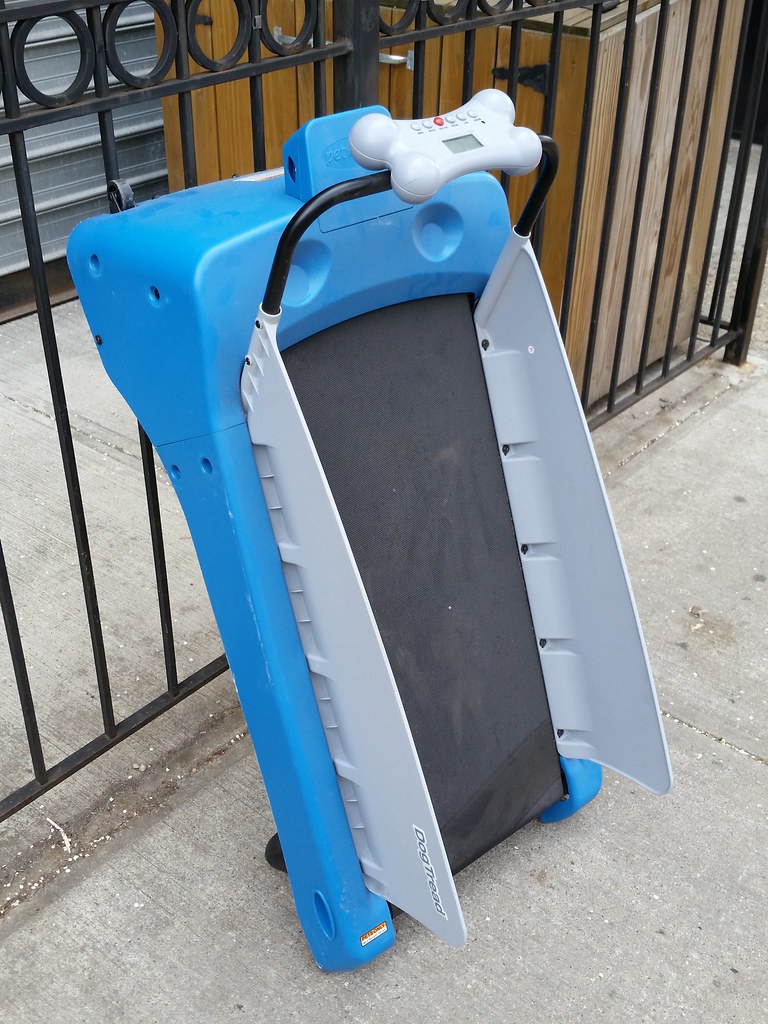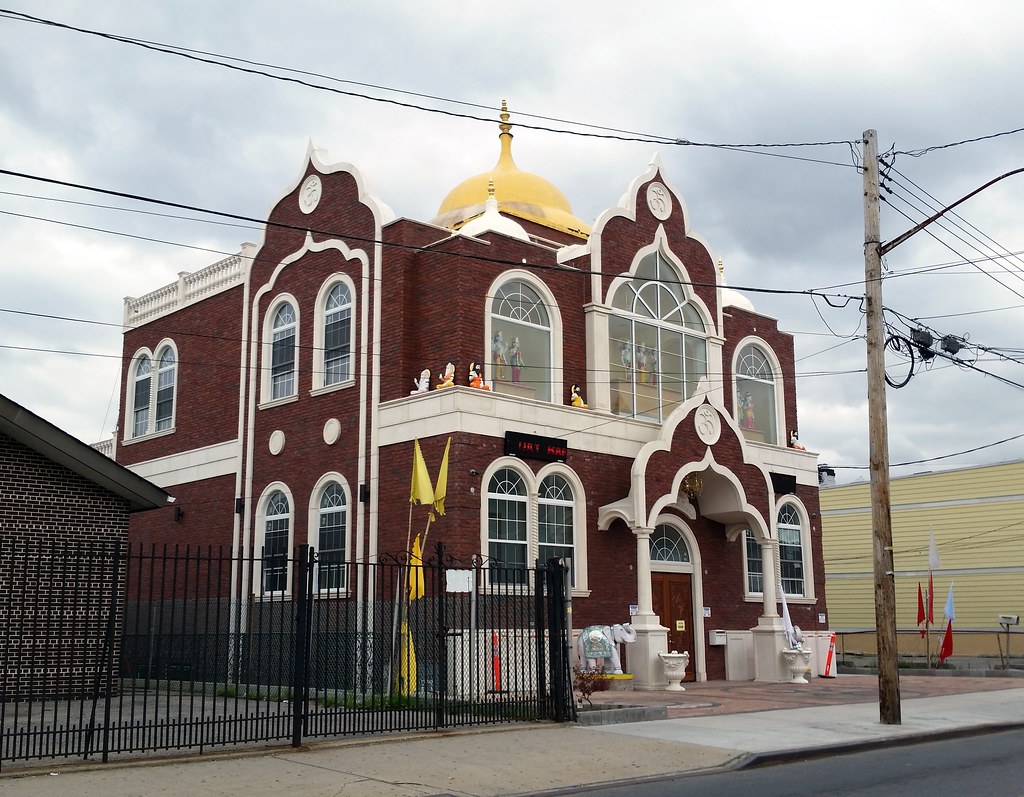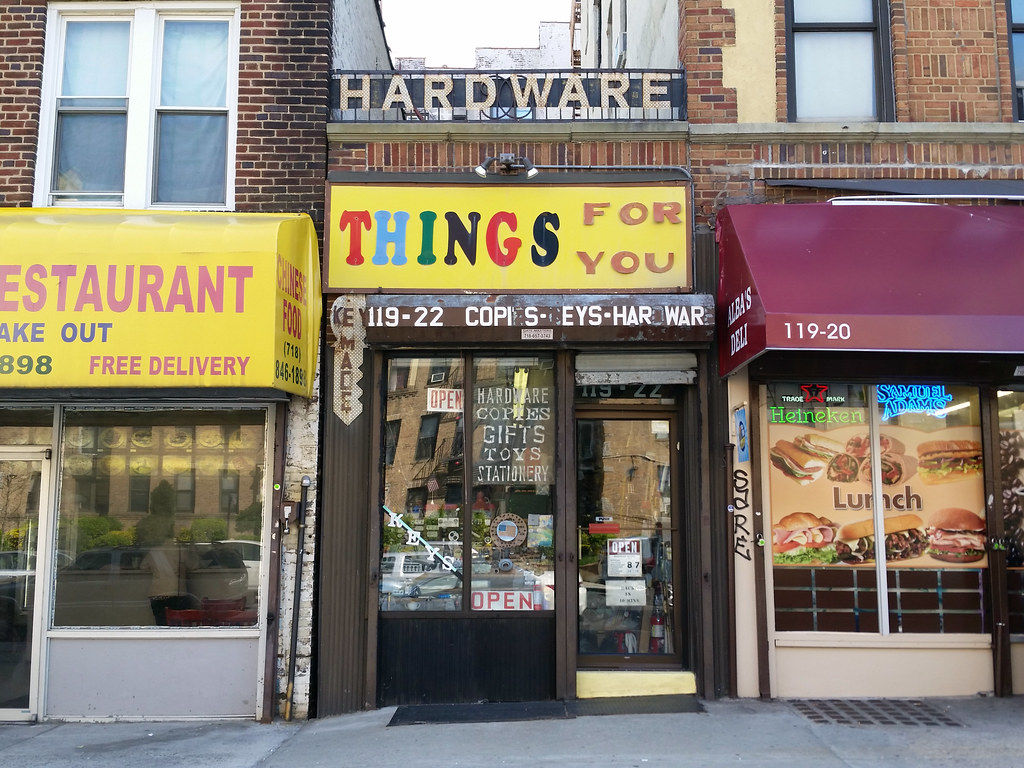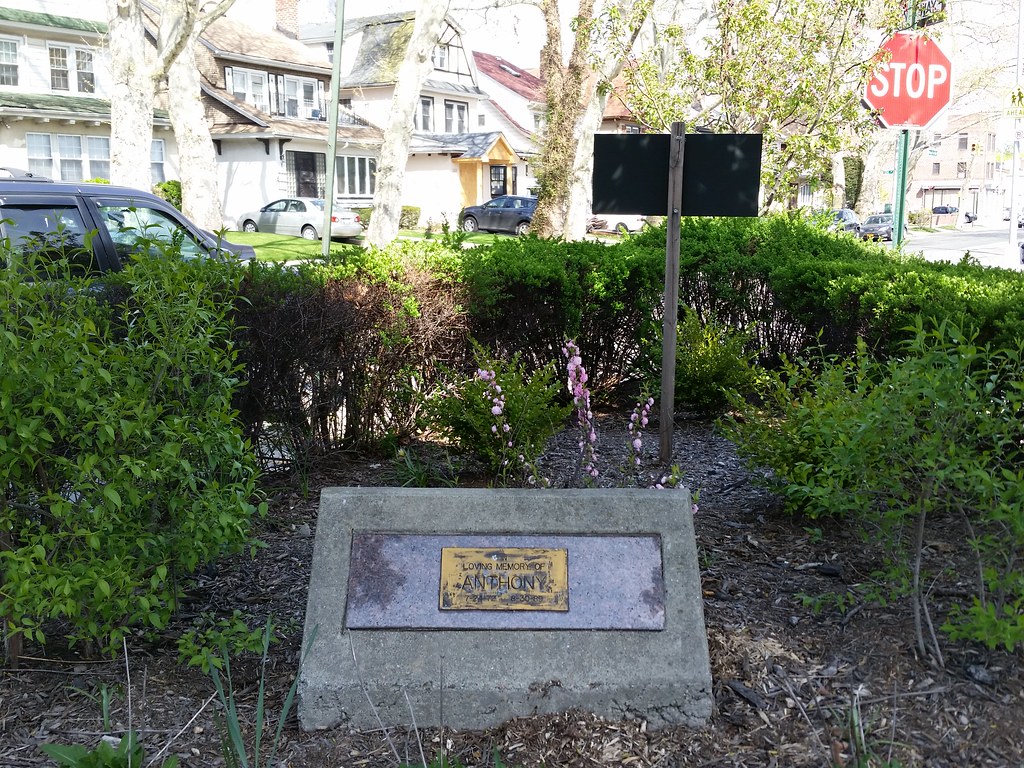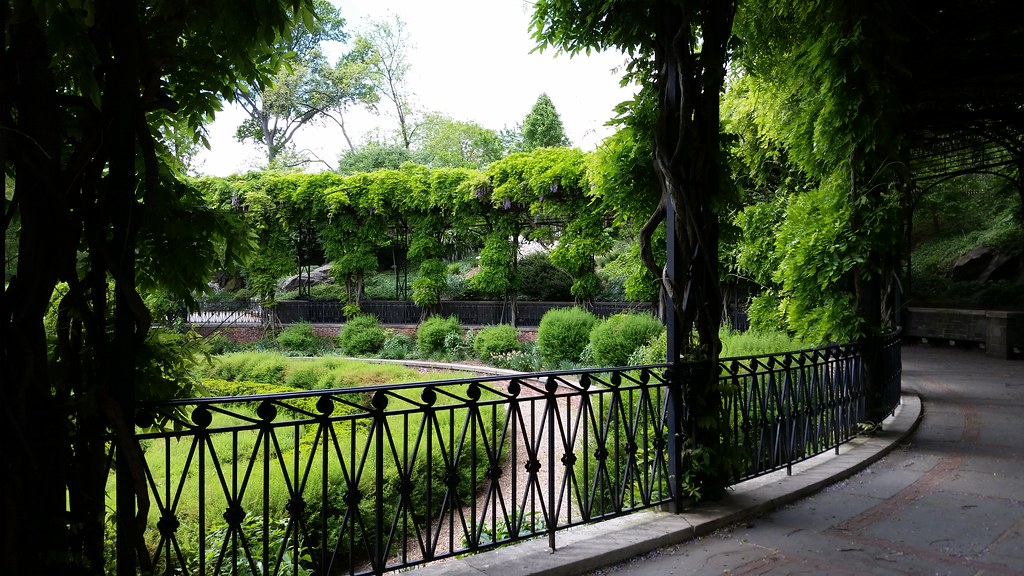

Built around 1870, this "rare, relatively intact example of the Italianate-style villa in Queens" is now home to Once Upon A Time Inc., which runs a school and a theater company here.
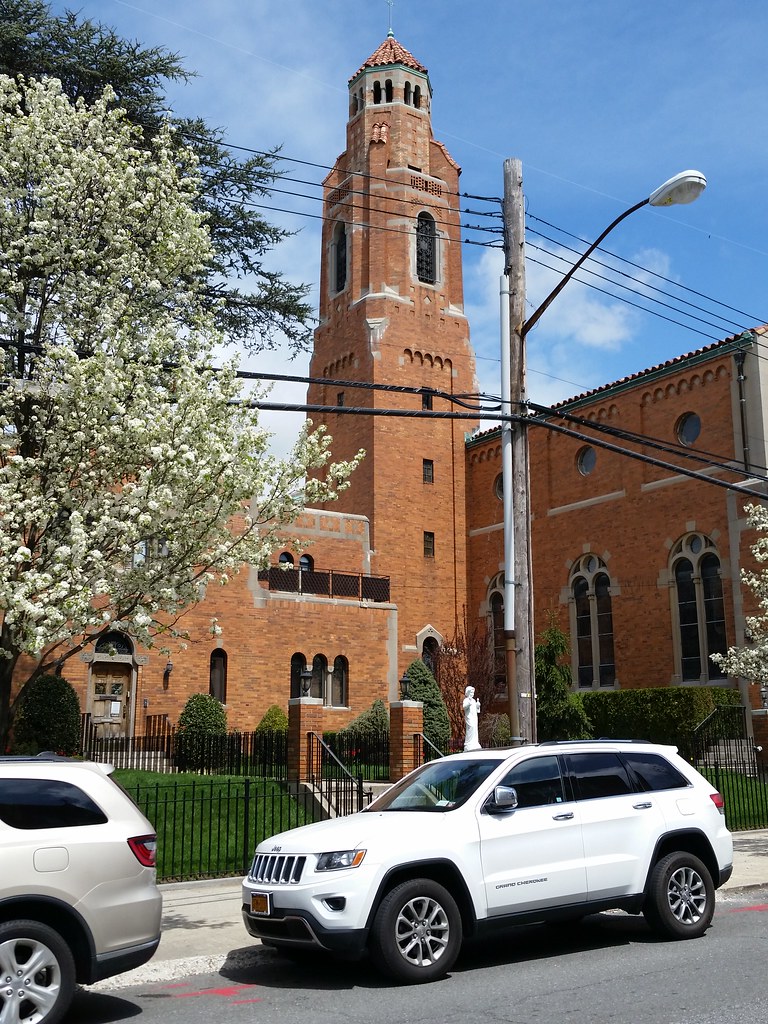
Built 1929-31
UPDATE: A few days before Thanksgiving in 2015, a mother left her newborn infant son at the church, inside an empty nativity scene that was being set up for Christmas. (No charges were filed against the woman, who was deemed to have acted within the spirit of the state's safe-haven law.) The parish priest put the incident in a positive light, saying "I think it's beautiful . . . A church is a home for those in need, and she felt, in this stable — a place where Jesus will find his home — a home for her child." Members of the church expressed interest in adopting the boy and suggested names for him. The priest said that there were "a number of people within the community that would love to see him stay with us . . . He's a member in our hearts."
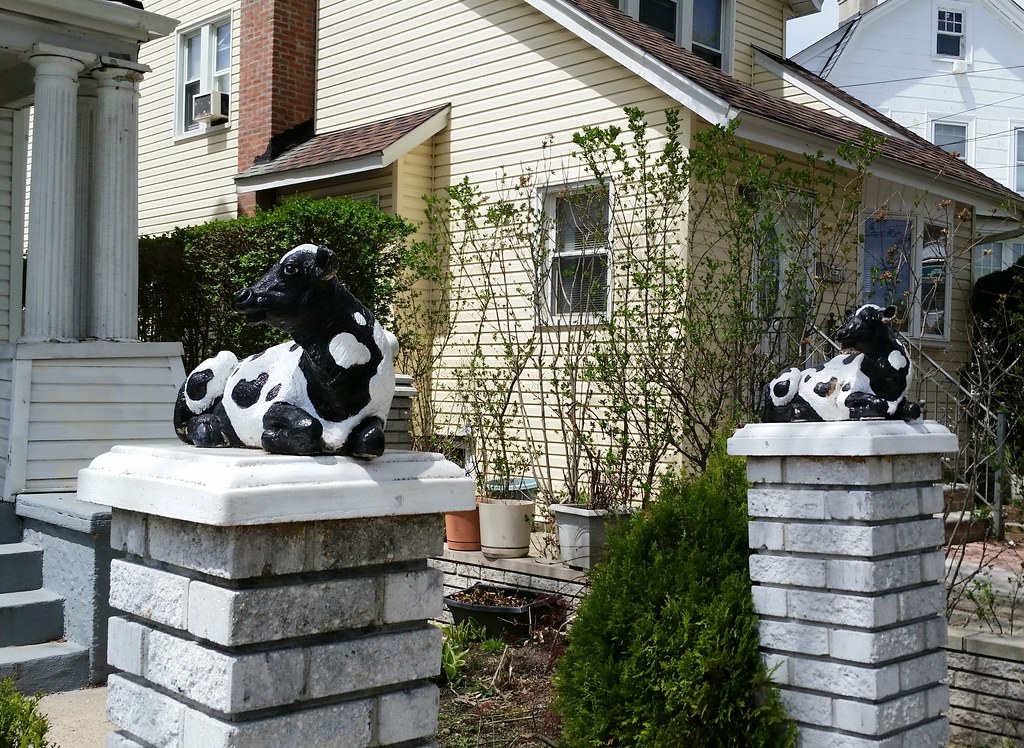
Lions and foo dogs are a dime a dozen, but these cattle are a new addition to the menagerie. Given that we're in Richmond Hill, it's probably a good bet that a Hindu family lives here; there's also a pair of elephants watching over the driveway.
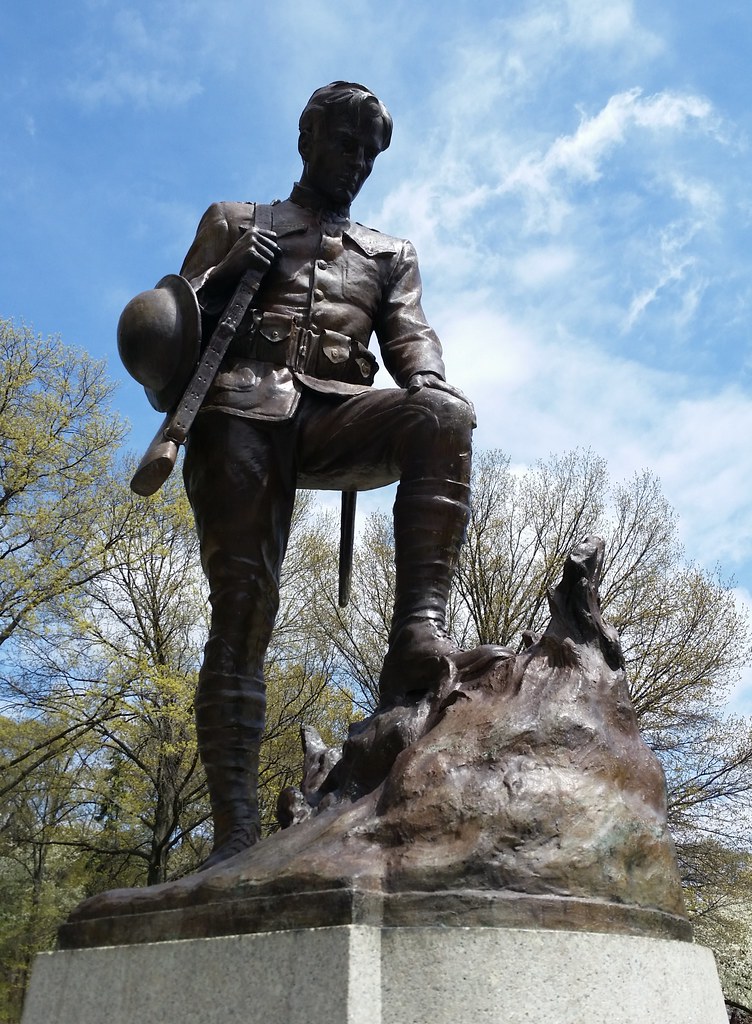
Standing at the edge of Forest Park, this monument, also known as My Buddy, honors the residents of Richmond Hill who served and died in World War I. The doughboy figure was sculpted by the Italian-born Joseph Pollia. (Pollia later produced other versions of the statue for Glen Cove and Tarrytown, New York, and Storm Lake, Iowa.) The monument's architect was William Van Alen, who would go on to design one of New York's most iconic structures, the Chrysler Building.

This Forest Park memorial pays tribute to Staff Sgt. Joseph E. Schaefer, a Richmond Hill resident who was awarded the Medal of Honor for "having repelled, almost single-handedly, a Nazi attack on American troops positioned near Stolberg, Germany" during World War II. You can read his full Medal of Honor citation here.

This "fountain made of glacial rocks" (a bit of an overstatement) and the basketball courts behind it sit on the former site of Jackson Pond, once a popular recreational spot here in Forest Park. You can trace the progression of the site over the years using aerial photos:
- 1924 — The pond exists in a relatively natural state.
- 1951 — You can see the concrete shoreline that was built about ten years earlier.
- 1996 — The pond is gone, but the concrete shoreline is still clearly visible. The pond was filled in around 1966, covered with concrete, and turned into a pond-shaped playground.
- 2006 — Greenery! The playground was reconstructed around 2001 and is no longer a lifeless expanse of concrete. One remnant of the pond can still be seen: a short retaining wall running around most of the perimeter of the site.

Forest Park may not boast a large, sanctioned dirt jump course like the ones we've seen in a couple of other parks, but it is home to at least one rogue jump tucked away among the trees.

A relevant read from Slate: "Pop Art: The brilliant redesign of the soda can tab".
And if that's not enough for you, check out this surprisingly captivating video: "The Ingenious Design of the Aluminum Beverage Can".

Some freight trains still run on the Lower Montauk Branch, but the last trickle of passenger service dried up back in 2012.

Early on in my walk, I primarily came across this invasive wildflower in the Bronx, but I've seen a lot of it in Queens's Forest Park and the adjacent neighborhoods of Richmond Hill and Woodhaven in recent days.

This stately Kew Gardens residence appears to be unoccupied, and probably has been since late 2010, when the Department of Buildings issued a "full vacate order" after it determined, in response to a complaint, that the place had been turned into a "transient hotel" with 48 beds in 14 rooms. The house was forfeited to the federal government in 2011 along with four other properties owned by Irina Khaimov and her family that "constitute[d] or [were] derived from proceeds traceable to the commission of bank fraud and . . . [were] involved in money laundering".
Many years ago, 115-98 Park Lane was home to Lillian Lemmerman and (I would imagine) her husband Fred. At the time of Lillian's death in 1929, Fred was president of the Queensboro Chamber of Commerce. In 1933, he was appointed by Mayor O'Brien, a Tammany Democrat, as one of the three commissioners of the new Triborough Bridge Authority, a public authority charged with funding, building, and operating the bridge-to-be.
Shortly after taking office in 1934, however, Mayor La Guardia ousted Lemmerman and another commissioner and replaced them with appointees from his own party. One of those appointees was Robert Moses, who had drafted the legislation that created the authority in the first place, and who would go on to lead the authority until it was merged into the new MTA in 1968. Much of Moses's legendary power as New York's "master builder" came from his control of the tremendous revenues generated by the bridge's tolls and by tolls on other crossings later operated by the authority (which became the Triborough Bridge and Tunnel Authority in 1946). This huge money pot provided him with an independent source of funding for his infrastructure projects that was "free of any public or governmental interference".
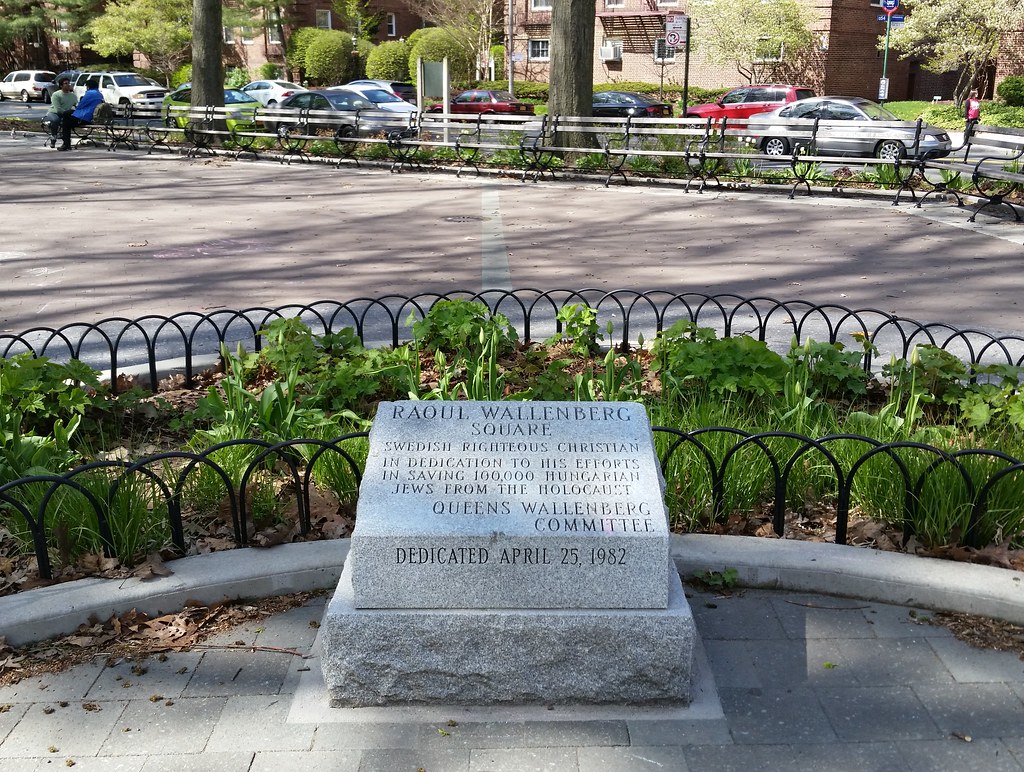
Born into a wealthy Swedish family in 1912, Raoul Wallenberg studied architecture at the University of Michigan (and spent some time hitchhiking — "travel[ing] like a hobo" — around the US) before returning to Sweden, where family connections helped land him a job at an export-import firm. It would be fair to say that he seemed like an unlikely candidate to become the savior of tens of thousands of Jews during the Holocaust.
But in 1944 he was recruited by the US War Refugee Board to enter Hungary under Swedish diplomatic cover and lead an operation to save as many of the country's Jews as possible from being sent off to concentration camps. He turned out to be brilliant and fearless in this role, as illustrated by the following excerpts from this case study published in the Journal of Leadership & Organizational Studies in 1998:
[Wallenberg] conceived a plan whereby false Swedish passports . . . would be created and used to give potential victims safe passage out of Nazi-controlled territory. In conjunction with this, a series of safe-houses would be established within Hungary, in the guise of official Swedish legation buildings under diplomatic protection.You can read more about the man, and about his reported execution in a Soviet prison in 1947, here.
. . .
Sandor Ardai was sent by the Jewish underground to drive for Wallenberg; Ardai later told of one occasion when Wallenberg intercepted a trainload of Jews about to leave for Auschwitz. Wallenberg swept past the SS officer who ordered him to depart. In Ardai's words,"Then he climbed up on the roof of the train and began handing in protective passes through the doors which were not yet sealed. He ignored orders from the Germans for him to get down, then the Arrow Cross men began shooting and shouting at him to go away. He ignored them and calmly continued handing out passports to the hands that were reaching out for them. I believe the Arrow Cross men deliberately aimed over his head, as not one shot hit him, which would have been impossible otherwise. I think this is what they did because they were so impressed by his courage. After Wallenberg had handed over the last of the passports he ordered all those who had one to leave the train and walk to the caravan of cars parked nearby, all marked in Swedish colours. I don't remember exactly how many, but he saved dozens off that train, and the Germans and Arrow Cross were so dumbfounded they let him get away with it!" (Bierman 91)As the war situation deteriorated for the Germans, Eichmann diverted trains from the death camp routes for more direct use in supplying troops. But all this meant for his victims was that they now had to walk to their destruction. In November 1944 Eichmann ordered the 125-mile death marches, and the raw elements soon combined with deprivation of food and sleep to turn the roadside from Budapest to the camps into one massive graveyard. Wallenberg made frequent visits to the stopping areas to do what he could. In one instance, Wallenberg announced his arrival with all the authority he could muster, and then,"You there!" The Swede pointed to an astonished man, waiting for his turn to be handed over to the executioner. "Give me your Swedish passport and get in that line," he barked. "And you, get behind him. I know I issued you a passport." Wallenberg continued, moving fast, talking loud, hoping the authority in his voice would somewhat rub off on these defeated people... The Jews finally caught on. They started groping in pockets for bits of identification. A driver's license or birth certificate seemed to do the trick. The Swede was grabbing them so fast; the Nazis, who couldn't read Hungarian anyway, didn't seem to be checking. Faster, Wallenberg's eyes urged them, faster, before the game is up. In minutes he had several hundred people in his convoy. International Red Cross trucks, there at Wallenberg's behest, arrived and the Jews clambered on... Wallenberg jumped into his own car. He leaned out of the car window and whispered, "I am sorry," to the people he was leaving behind. "I am trying to take the youngest ones first," he explained. "I want to save a nation." (Marton 110:11)This type of action worked many times. Wallenberg and his aides would encounter a death march, and, while Raoul shouted orders for all those with Swedish protective passports to raise their hands, his assistants ran up and down the prisoners' ranks, telling them to raise their hands whether or not they had a document. Wallenberg "then claimed custody of all who had raised their hands and such was his bearing that none of the Hungarian guards opposed him. The extraordinary thing was the absolutely convincing power of his behavior," according to Joni Moser. (quoted in Bierman 90)
. . .
Tommy Lapid was 13 years old in 1944 when he was one of 900 people crowded 15 or 20 to a room in one of the Swedish safehouses. His account illustrates not only vintage Wallenberg tactics, but also how Wallenberg epitomized hope and righteousness, and how his influence extended throughout the land as a beacon to those engulfed in the darkness of despair."One morning, a group of these Hungarian Fascists came into the house and said all the able-bodied women must go with them. We knew what this meant. My mother kissed me and I cried and she cried. We knew we were parting forever and she left me there, an orphan to all intents and purposes. Then, two or three hours later, to my amazement, my mother returned with the other women. It seemed like a mirage, a miracle. My mother was there--she was alive and she was hugging me and kissing me, and she said one word: "Wallenberg." I knew who she meant because Wallenberg was a legend among the Jews. In the complete and total hell in which we lived, there was a savior-angel somewhere, moving around. After she had composed herself, my mother told me that they were being taken to the river when a car arrived and out stepped Wallenberg--and they knew immediately who it was, because there was only one such person in the world. He went up to the Arrow Cross leader and protested that the women were under his protection. They argued with him, but he must have had incredible charisma, some great personal authority, because there was absolutely nothing behind him, nothing to back him up. He stood out there in the street, probably feeling the loneliest man in the world, trying to pretend there was something behind him. They could have shot him then and there in the street and nobody would have known about it. Instead, they relented and let the women go." (Bierman 88-89)
I'll end this post with two pieces of Wallenberg trivia:
1) In 1981, he was posthumously made an honorary US citizen. At that time, only one other person had ever been given honorary US citizenship: Winston Churchill. (Six others have in the years since.)
2) One of the Hungarian Jews he saved was Tom Lantos, who would go on to become the only Holocaust survivor to serve in the US Congress.
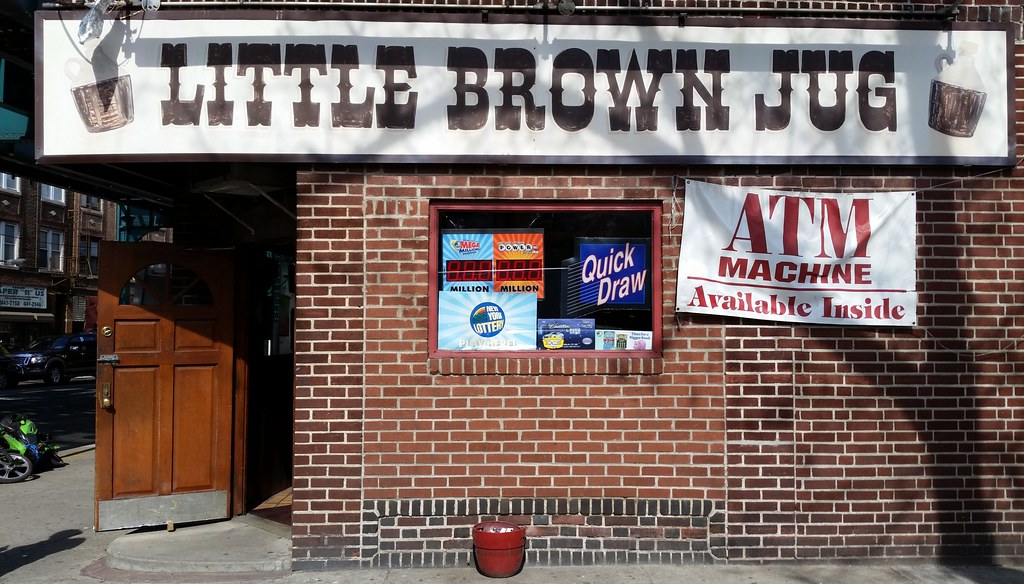
This bar is named after a jaunty old folk tune that celebrates the joys of alcoholism.
'Tis you who makes my friends my foes,
'Tis you who makes me wear old clothes;
Here you are, so near my nose,
So tip her up, and down she goes.
Ha ha ha, you and me,
Little brown jug don't I love thee.
Ha ha ha, you and me,
Little brown jug don't I love thee.
In 1948, Famous Studios released a mildly disturbing Screen Song animated short called "Little Brown Jug" in which an array of animals, many of whom are babies, get plastered by drinking from a cider-filled river — or by being born to, or suckled by, a drunken mother. The boys and girls watching the cartoon are invited to sing along to a version of "Little Brown Jug" with new, though similarly themed, lyrics.
Fellows caught in swinging doors,
Faces on the bar room floors.
Old men full of pep and zing,
And it all comes from just one thing.
Ha ha ha, hee hee hee,
Little brown jug how I love thee.
Fiddle dum and fiddle dee,
Little brown jug oh you're for me.
The song concludes with the titular little brown jug and a quartet of hallucinatory pink elephants performing the final line of the chorus together.
You can watch the film here. It's best enjoyed with a bowl of buttery popcorn and a jug of your favorite intoxicant.

After photographing this bizarre facade (just two doors down from the Little Brown Jug), I discovered that it makes an appearance as the exterior of a mobster warehouse in the 1990 movie Quick Change, starring and co-directed by Bill Murray (his only directing credit to date, in fact).
You can just barely make out the fan pattern as the main characters open the door at the beginning of this scene, in which they encounter the mobsters. But the building is easily recognizable, though partially painted blue and graffitied, in this subsequent scene, at 2:36, when Mario, "that big bald giant with the stupid sunglasses", walks up to the door.


The first time I noticed one of these buildings, I wasn't sure what it was. But having seen a number of them now, I recognize the key features, particularly the windows. It's a well pumping station formerly operated by the Jamaica Water Supply Company (JWS).
With a network of groundwater wells, JWS once provided water to southeastern Queens and parts of Nassau County. NYC bought the Queens wells in 1996, but hasn't used any of them for drinking water since 2007; all of the city's water — more than a billion gallons per day — now comes from upstate reservoirs. About half of that supply is carried toward the city through the Delaware Aqueduct, which will have to be shut down for several months for repair work around 2022. There was talk of rehabilitating the wells in Queens to help compensate for the loss of water while the aqueduct is out of service, but, as far as I can tell, that plan is no longer being considered.
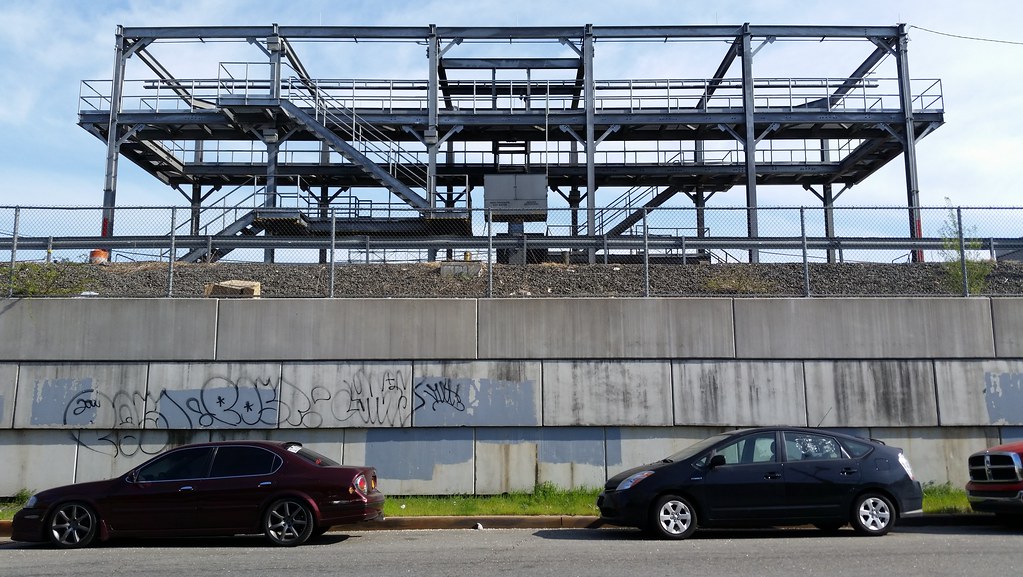
Atop the wall, largely hidden from view here at street level, is the Long Island Rail Road's Richmond Hill yard. Within the yard is a car wash facility — one of three in the LIRR system — for bi-level rail cars. The two green-roofed structures in this aerial view of the yard are car wash sheds. The structure above, which can be found in the upper right portion of that aerial view, is only a few years old (it was under construction in 2013), and it appears to have some car-washing function as well: if you zoom in on the gray box near the middle of the photo, you'll see two labels reading "HIGH PRESSURE HOT WATER" and "HEATED DETERGENT". Looking again at the aforementioned aerial view, you can see that this structure straddles a track; perhaps it's designed to allow people to walk around the elevated platform and manually wash a rail car sitting beneath it.
Just to the west of the car wash is the adjacent Morris Park yard. Looking at an aerial view of Morris Park, you can see a roundhouse and its turntable — apparently the LIRR's last active turntable.

The Jamaica Water Supply Company once provided southeastern Queens and parts of Nassau County with drinking water pumped up from local wells. NYC bought the company's Queens properties in 1996, but hasn't used any of the wells to supply water since 2007. Like the rest of the city, southeastern Queens now gets all its water from upstate reservoirs.
The water tower above, now owned by the city, is one of several of the company's old storage tanks that can be found in southeastern Queens. (Now a solid light blue, it used to be painted much more festively, as you can see in this 1964 photo. Note also, at the far right of the photo, the directional sign for the 1964 World's Fair.) I've previously posted photos of a few of the other old tanks, and I saw another tower very similar to the one above earlier today.

This tiny piece of parkland in Richmond Hill honors Jacob Riis, the social reformer, muckraking journalist, and flash photography pioneer who was also, fittingly, a champion of turning unused plots of land into small parks.
Riis moved to Richmond Hill with his wife and children in 1886. He had discovered the town on a long walk one day in 1884, and he was so impressed with what he called "the most beautiful spot I had ever seen" that he returned the next day to select a lot for his family's future house. He lived in the community for many years and became a member of the Church of the Resurrection, having left his previous church because it would not invite him to present his slide show lecture — the predecessor of his seminal 1890 book How the Other Half Lives — about the appalling living conditions endured by the city's poor.

Old & Rare Books Since 1954
This store was originally located on Austin Street in Kew Gardens, hence the name. It was right outside the original shop, late one night in 1964, that the infamous murder of Kitty Genovese began.

This "seafood sports lounge" has been coming soon for a few years now.
Or, as "Lambsy" put it:
More like "Fish, Fish, NO Fish", am I right!?(This is in Prospect Heights; I saw it after returning from my walk.)
But seriously, is this place ever going to open?
UPDATE: It's finally open! It seems like it's just a seafood restaurant though, not a sports lounge. (According to one local, it was unable to get a liquor license because a storefront church down the block expanded to occupy an entire building. State law prohibits an establishment from being granted a liquor license if it is located on the same street as and within 200 feet of a building that is used "exclusively" as a place of worship.)
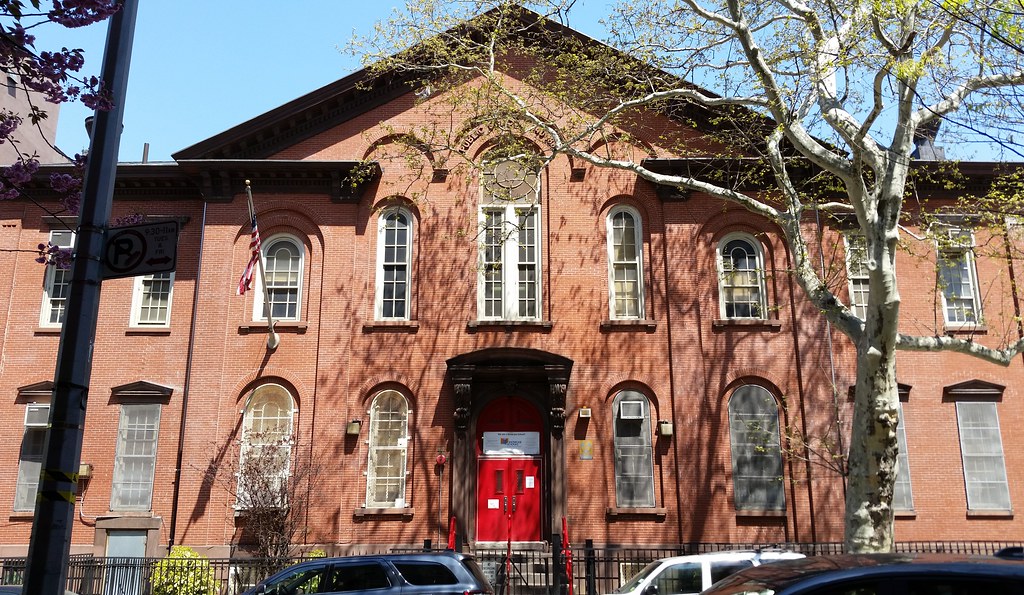
This Romanesque Revival structure near Grand Army Plaza in Prospect Heights opened in 1868 as Public School 9, later served as Public School 111, and is now home to Intermediate School 340. You can see some photos from inside the school here.
When PS 9 began holding classes in the new building in September 1868, the school also had a new principal: Jane Dunkley, "the first woman put in charge of a grammar school" in Brooklyn, according to the Brooklyn Daily Eagle, or at least "the first woman appointed in Brooklyn to preside over a large grammar school", according to the city's Landmarks Preservation Commission.
(Another woman, Agnes Humphrey/Humphreys, is cited by the Daily Eagle on another occasion as being Brooklyn's first female grammar school principal, and other Daily Eagle articles [1, 2] seem to suggest that Ms. Humphrey became principal of PS 27, which the paper describes as "one of the largest [schools] in the city [of Brooklyn]", earlier in 1868, some months before Ms. Dunkley took over at PS 9.)
By the early 1860s, Ms. Dunkley was a well-regarded vice principal at Brooklyn's PS 15 (the building that served as PS 15 in those days is still standing), and within a few years she had made it clear that she wanted to become head principal. But while the vast majority of public school teachers at the time were female, there was still much resistance to the idea that a woman could effectively lead an entire school. Looking at excerpts from Daily Eagle articles over the years, we can learn a little about how Ms. Dunkley rose to become head principal of PS 9, and also about the various attitudes people held at the time about women's roles in the educational system.
I'll start by quoting from a general article about the schools of Brooklyn, in part to provide some background information about the public school system, but mostly because it's just funny, and then I'll move on to a chronological series of articles that specifically mention Ms. Dunkley. You'll notice that she is sometimes referred to as the principal of PS 15 in pre-1868 articles, but this must just be a form of shorthand, as evidence from other articles overwhelmingly indicates that she was a vice principal, possibly in charge of the primary school students.
September 28, 1868: The "forty school houses" mentioned here are all the public school buildings in Brooklyn at the time.
In these forty school houses, under the charge of the Board of Education, there are engaged five hundred and eighty-nine teachers, of whom only twenty-seven are males, and the remaining five hundred and sixty-two are females—a fact which, more than all else, speaks volumes of hope and trust for the rising generation. It is a fact within the memory of most grown people, that not a quarter of a century since, the idea of females as teachers to boys, anywhere except in an infant school, would have been looked upon as absurd in the extreme, for it was argued after the old system that education could only be made to take root in the mind of a boy by the daily and vigorous application of a stout rattan or cowhide. Experience has proved that this idea is erroneous, and the experience of the principals in our public schools is, that the female assistants are by far the most useful in imparting knowledge, for while a male teacher is apt to get angry and excited, and so create in the mind of the pupil similar emotions by the sudden infliction of an unlooked for chastisement, the gentleness and patience of the female teacher wins the regard of the pupil and creates a spirit of chivalry and respect for the sex in the boy, which is one of the best safeguards in after life against his falling into brutal habits.
November 3, 1863: An article titled "THE RUSSIANS IN BROOKLYN" describes a visit to PS 15 by Admiral David Farragut and a contingent of Russian naval officers. The Russians had arrived in New York Harbor aboard six warships in mid-September to the great excitement of many Northerners, who perceived their presence, in the midst of the Civil War, to be a show of support for the Union. Lavish celebrations were held for the Russians — a parade, banquets, a grand ball — and apparently PS 15 was chosen as the first school that they should be taken to see.
The pupils of Public School No. 15, to the number of some twelve hundred, held high festival today on the occasion of a visit from Admiral Lovinsky and suite and Admiral Farragut and lady to the school. . . .
As this was the first visit made by the Russian officers to any of the public schools in this country, the preparations for their reception, under the management of Mr. Taylor, the Principal, and Mrs. J. A. Dunkley, Vice-Principal, were of the most creditable character, and must have impressed the visitors very favorably.
March 7, 1866
The Academy of Music this evening will be filled with the pupils of School No. 15, and their friends, to participate in and listen to the entertainment to be given this evening by the Primary Department of the School, under the direction of Mrs. Dunkley, who has long acted as the efficient principal of the school.
October 2, 1867
The Board of Education last evening increased the salary of the lady principal of Public School No. 15 (Mrs. Dunkley) to one thousand dollars per annum. Due mainly to her ability, tact, and energy No. 15 has acquired more than a local reputation. While we do not desire that the case should not be accepted as a precedent, it will serve to show that we are willing to remunerate conspicuous talent in our teachers whenever we find it. It is a curious commentary on the labor problem that there is no reason in the world why Mrs. Dunkley should not have the same pay as the male principals except the fact that she is a woman.
October 3, 1867
During the week, afternoon exhibitions of the Apocalypse have been given for the accommodation of the public schools. Tuesday a special matinee was given in order to enable the pupils of School No. 15, under charge of Mrs. Dunkley, Principal, to attend. Nearly a thousand children were in attendance, and without desiring to detract from the merits of the entertainment, we must confess that to witness the perfect order and general appearance of the pupils assembled at the Atheneum on this occasion was worth as much as the admittance fee to the exhibition.
May 20, 1868: A letter to the editor in favor of Ms. Dunkley's promotion.
Now for the suggestion to our Board of Education:
As some of the most successful educational enterprises in our land [have] been accomplished by women, and as Mrs. Dunkley has already given every evidence in her conduct of School No. 15, of her being in every respect qualified to effect similar results, with the proper means. As those who have given most attention to the subject of teaching are led to assign [women] a first rank in its profession, and as Mrs. Dunkley is worthy in every way of being advanced to larger than her present educational trusts, will not our Board give her a principalship that shall allow her ability full scope?
May 21, 1868: Another letter to the editor in favor of Ms. Dunkley's promotion.
I was pleased to see in last evening's Eagle a demand on our Board of Education to place Mrs. Dunkley in charge of No. 15. This is just and should be listened to. My children attend that school, and nothing would tempt me to second the motion, but an honest conviction that Mrs. Dunkley's promotion would be not only for the interests of No. 15, but would also add greatly to the efficiency of the profession.
At present a man Principal has no fear that his abler assistant may succeed him, for she is a woman. Let our Board of Education stir up competition by appointing Mrs. Dunkley to a principalship, as suggested by your correspondent last evening, and our public school matters will assume new life. Try it.
Don't let Mrs. Dunkley leave No. 15 for a field that will offer full scope for her ability.
June 3, 1868 (part 1, part 2): A report on a Board of Education meeting recounts a discussion among the (male) board members about a proposal to remove the male principal of PS 15 and replace him with Ms. Dunkley. Mr. Fields reveals himself to be an old stick in the mud.
Mr. Fields thought it was time to put a stop to the idea of experiment in our public schools; it was too bad that every one who got a whim in his head should try it upon the system of education, the teaching of youth had everywhere been placed in the hands of male principals, and why should the experiment of placing the delicate machinery of the human mind under the control of a woman be tried in Brooklyn? He thought it a pity to allow any woman to educate lads how to fight with men in the pursuit after their daily bread. No woman could give a commercial education fitted for these times of competition.
. . .
Mr. Kinsella thought . . . There had been a great deal of foolish talk about the inability of women to educate the youhtful mind, but his experience was, that those who had succeeded best in life had followed most implicitly the instruction of the women each of us held in most sacred remembrance. On a recent occasion he had been classed among the "old fogeys" of this Board, but in this matter he intended to be found among the most advanced in the line. He believed the inefficiency of our teachers—if inefficiency existed—was owing to the fact that no adequate reward was held out to them to make teaching a profession, and he proposed by this experiment to hold out something worthy a woman's ambition in the fact that they could attain to the highest position we had to give, if found competent.
July 11, 1868: Another account of a Board of Education meeting. Mr. Fields is at it again.
Dr. Conkling presented a resolution from the Teachers' Committee and Local Committee of No. 9, recommending the appointment of Mrs. Dunkley as Principal of No. 9, from Sept. 1st, 1868. The recommendation was signed by all the Committee of No. 9 and Mr. Whitlock of the Teachers' Committee.
Mr. Fields presented a minority report signed by Dr. Conkling, Mr. Stearns and himself. The document was a very lengthy and carefully constructed one. The main points raised in objection to the appointment of Mrs. Dunkley were as follows: 1st, that the plan was revolutionary; 2d, the experiment would be too costly; 3d, such a course would greatly disappoint the patrons of the school; 4th, grave doubt as to Mrs. D.'s experience being such as to make her fit for the position. The report closed with the following resolution:
Resolved, That the teachers and local committee be directed to select a competent male teacher for Principal of Grammar School No. 9, and report his name to this Board for information.
Mr. Seabury moved the adoption of this report.
Mr. Northrup thought he should have written a statement to read from the majority, for that of the minority was a powerful document, and did credit to the gentleman who had read it. He would have liked to have been present at the reception of No. 15, and to have heard the gentleman's eulogy on female teachers. In plain language he considered all Mr. Fields had read bosh and bogas and read as buncombe, and he didn't believe the gentleman believed one word of what he had said.
. . .
After some discussion the previous question was ordered by 17 ayes to 14 noes. Mr. [Fields's] amendment was lost, 13 to 18, and the motion appointing Mrs. Dunkley was carried—17 to 14.
September 5, 1868: An article about the upcoming school year.
Peculiar interest attaches to the opening of the new school, No. 9, from the fact that it has been placed [under] the charge of a lady principal, Mrs. Dunkley, whose marked success as teacher and principal of the female department of School No. 15, inspired the Board of Education with such confidence in her ability that they have entrusted her with the sole charge of the new school. The experiment will no doubt be watched with much interest. Hitherto but little inducement has been held out to the teachers in our public schools beyond their salaries which have never been liberal; the well remunerated position of principal in the schools has heretofore been reserved for men, while women have filled all the lower positions and done all the hard work. Of the capacity of women for teaching there is no longer any question; of her capacity for the government of a school, further proof is yet wanted to silence the doubter. The ladies have been fortunate in this instance in their representative, and they may await the result with confidence.
December 24, 1868: A story about the Christmas exhibition given by the students of PS 9.
Dr. West addressed the school in a few and appropriate words, during which he paid a high compliment to the talent of Mrs. Dunkley and congratulated the citizens of that part of Brooklyn in having such an institution as School No. 9. He had been associated in a school in New York some twenty years ago with Mrs. Dunkley and had then formed a high opinion of her abilities, since he had closely watched and was gratified at the success which had attended her.
Ex-Judge Reynolds followed and said:
I must say I was never more disappointed—agreeably disappointed. It is one of the pleasantest things connected with what I have seen here to-day that it has tended to confirm in me an opinion which I have cherished some time. That opinion is, that the work of teaching can be as well—if not, in the main, I think, much better performed by women than by men. And not only that—I have believed that the work of organizing and disciplining and conducting a school might be as well done by a woman as by a man. And to-day I have seen it done. I can only express the hope that the Board of Education pay as well for this work when it is done by a woman as when it is done by a man. And the teachers and the scholars in this department will allow me to say that I consider the drill and discipline of the scholars in the room below (Primary Department) is no less admirable than here.
. . .
Mr. Wm. C. DeWitt said: I concur entirely in the notion that ladies should conduct the teaching in the common schools. I think a man looks bad "mousing" around a schoolhouse. (Laughter.) I don't think it is necessary that he should be there; and I know, from my own experience, that boys prefer female teachers. They like them better; they listen to them more complacently and more tenderly than to men.
January 23, 1872
The resignation of Mrs. Dunkley, Principal of Public School No. 9, is announced. Mrs. Dunkley had been confined to her residence by sickness for a considerable period. Her resignation leaves only one school in the charge of a lady Principal. It is to be hoped that the Board of Education will adhere to the principle they have adopted of not entirely excluding experienced lady teachers from the prospect of promotion to a principalship. It is by no mean every lady teacher, however skillful and experienced, that is fit to be a Principal; but the examples of Mrs. Dunkley and Miss Humphrey prove that a lady teacher may succeed admirably as a Principal. In filling Mrs. Dunkley's place, therefore, it is to be hoped that the authorities will promote or transfer some experienced lady teacher to the principalship of No. 9.
February 15, 1872: Not long after resigning because of illness, Ms. Dunkley (sometimes spelled Dunkly) passes away.
Mrs. Jane A. Dunkly, wife of Leonard Dunkly, Jr.
The friends and relatives are invited to attend the funeral services at 2½ P.M., on Saturday, 17th. at St. Luke's Episcopal Church, Clinton av, near Atlantic, Brooklyn.
The Leonard Dunkly mentioned above, Ms. Dunkley's husband, was also a principal. He presided over PS 16, which was apparently a renowned school. According to an 1881 article from the Daily Eagle:
The reputation of [PS 16] is well known. It is quoted from one end of the country to the other as a model school, not only in appointments but in intelligent methods of instruction, systematic organization, and the thoroughness of the work. For twenty-four years Mr. Dunkley has been recognized as one of the leading educators of Brooklyn.When Mr. Dunkly (his family apparently spelled the name without an "e") retired in 1902, the Daily Eagle ran an 11-paragraph tribute with a sub-headline reading "Principal's Life Devoted to an Elementary School Whose Results Are Historical."
Mr. Dunkly was held in such high esteem, in fact, that his name lives on in the public school system to this day. When I searched for information about PS 16, just to see if it's still located in the same place — it is, on Wilson Street between Bedford and Lee Avenues in Williamsburg, but in a newer building — I discovered with surprise the full name of the school: PS 16 Leonard Dunkly.
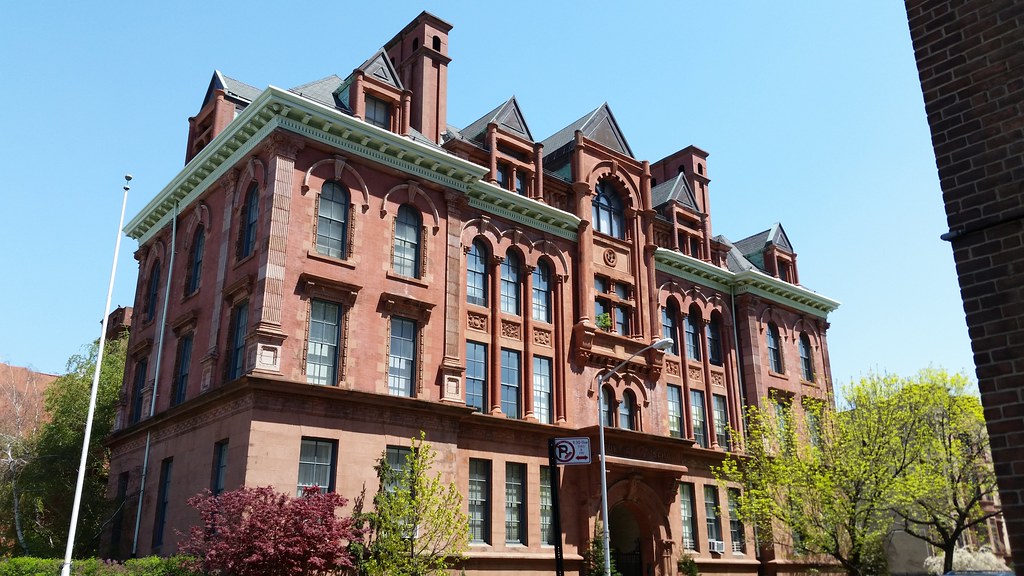
Located across the street from the old Public School 9, the Annex was built in 1895 to provide additional classroom space to accommodate the growing population of Prospect Heights. It was used as a community center for some time prior to 1989, when it was renovated and converted into apartments that supposedly retained "most of the existing configuration of the school's classrooms and corridors, with most apartments consisting of two classrooms." You can take a look inside the building and see a couple of the apartments here and here.
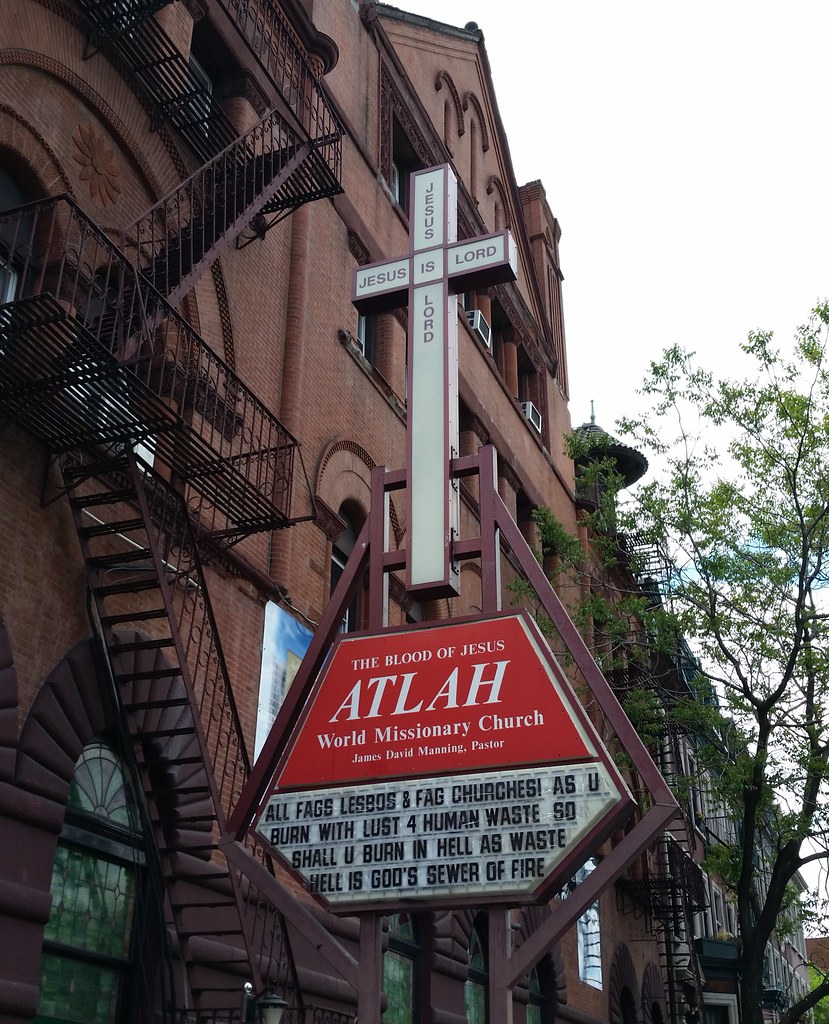
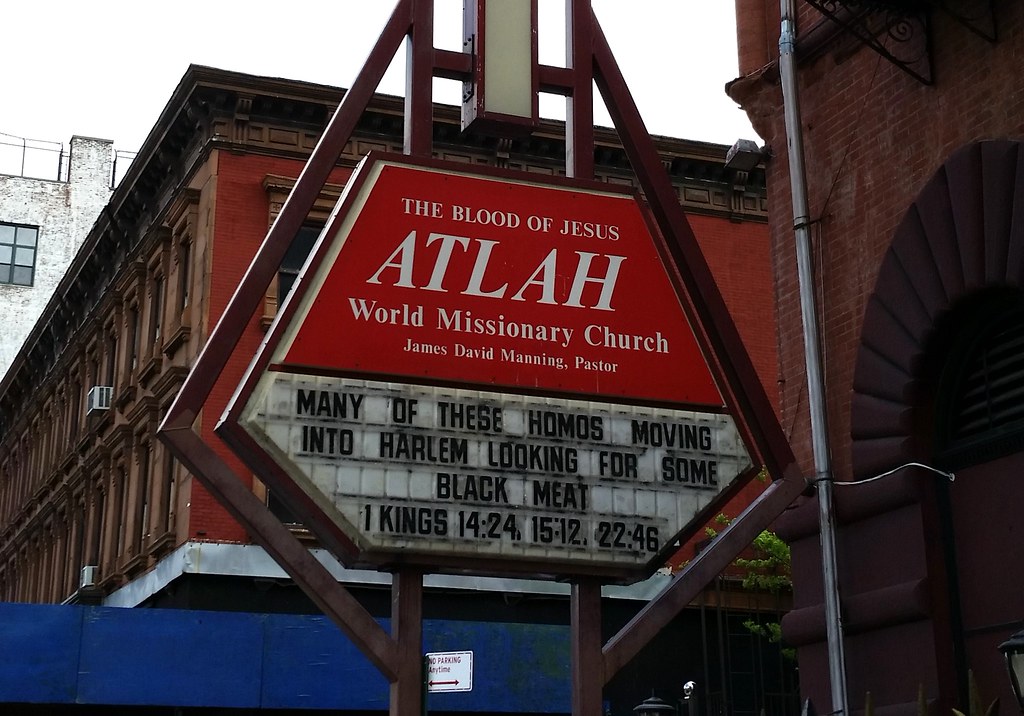
Absurd and hateful messages like these can often be found on display outside ATLAH World Missionary Church. The pastor, an ex-burglar named James David Manning, seems to truly believe the preposterous things he preaches (Oprah Winfrey is the Antichrist; Barack Obama, Bill Gates, and Bill Clinton are going to deport all the black people in America to Haiti and Africa; Starbucks flavors its lattes with sodomites' semen; and so much more), but I continue to hold out a small sliver of hope that he's just Andy Kaufman in disguise.
BREAKING NEWS from Pastor Manning: "Sodomites sent me a bucket of poop. . . . Somebody pooped in a bucket, in a plastic bucket, and they put a plastic lid on it, and they put it in a box and mailed it to me."
It turns out that the main public conduit of Manning's bigotry, the sign outside the church, was illegally installed. Because the church is located in a historic district, modifying the exterior appearance of the building — e.g., erecting a big sign — requires permission from the city's Landmarks Preservation Commission, which the church never sought. While ATLAH has been issued violations by the LPC for making multiple unauthorized alterations to the building, and may be fined as a result of those violations, my understanding is that the city has no power to force the church to remove the illegal sign.
UPDATE (February 26, 2016): ATLAH has indeed been fined for its LPC violations, but that's the least of its financial problems. Having never paid its water and sewer bills, the church now owes more than a million dollars and is facing foreclosure. Two of the leading candidates to buy the building if the church gets booted out are an LGBT-friendly church and a homeless shelter for LGBT youth.
You can learn more about the situation in this Daily Show video. Defiant in the face of foreclosure, Manning proclaims that "Sodomites will carry babies in their testicles for nine months and then gestate them out of their assholes before this church is closed."

sits beside the waters of Central Park's Harlem Meer. But how did it get here?

This is an aquatic weed harvester, one of two such boats owned by the city. (The other does its harvesting in Prospect Park Lake.) Here at the Harlem Meer in Central Park, the harvester is operated twice a week during the warmer months. It was originally intended to clear algae from the water, but then, once the algae was under control, curly-leaf pondweed took over. The masses of vegetation skimmed from the water are used to make compost for the park.


The plaque reads:
THIS EMINENCE COMMANDING
McGOWN'S PASS
WAS OCCUPIED BY BRITISH TROOPS SEPT 15 1776
AND EVACUATED NOV 21 1783
HERE BEGINNING AUG 18 1814 THE CITIZENS OF NEW YORK
BUILT FORT CLINTON TO PROTECT THE CITY
IN THE SECOND WAR WITH GREAT BRITAIN
THIS TABLET IS ERECTED BY THE CHILDREN OF THE
CITY HISTORY CLUB OF NEW YORK A.D. 1906
Here's some information about the cannons from the NY Times:
They were originally thought to have been installed to protect the city from a British invasion launched from Long Island Sound during the War of 1812. But an authoritative account by Sara Cedar Miller, a historian for the [Central Park Conservancy], dates the big guns back more than 240 years to the 28-gun HMS Hussar commissioned in England in 1763. . . .While doing some restoration work in January 2013, park workers removed a concrete plug from the mouth of one of the cannons and discovered that the gun was still loaded! They called in the NYPD bomb squad, who extracted a cannonball, gunpowder, and wool wadding. The police determined that the gunpowder was still good could and that, all these years later, the cannon could have been fired.
Attached to the British fleet in New York, the Hussar ran aground in treacherous East River currents in 1780 and sank. Because it was believed to be carrying an army payroll made up of gold, for more than two centuries the ship has attracted salvage efforts, which retrieved no gold but, among other artifacts, the two cannons, which — after languishing in salt water for as long as 80 years — were anonymously donated to Central Park in 1865 while it was still under construction.
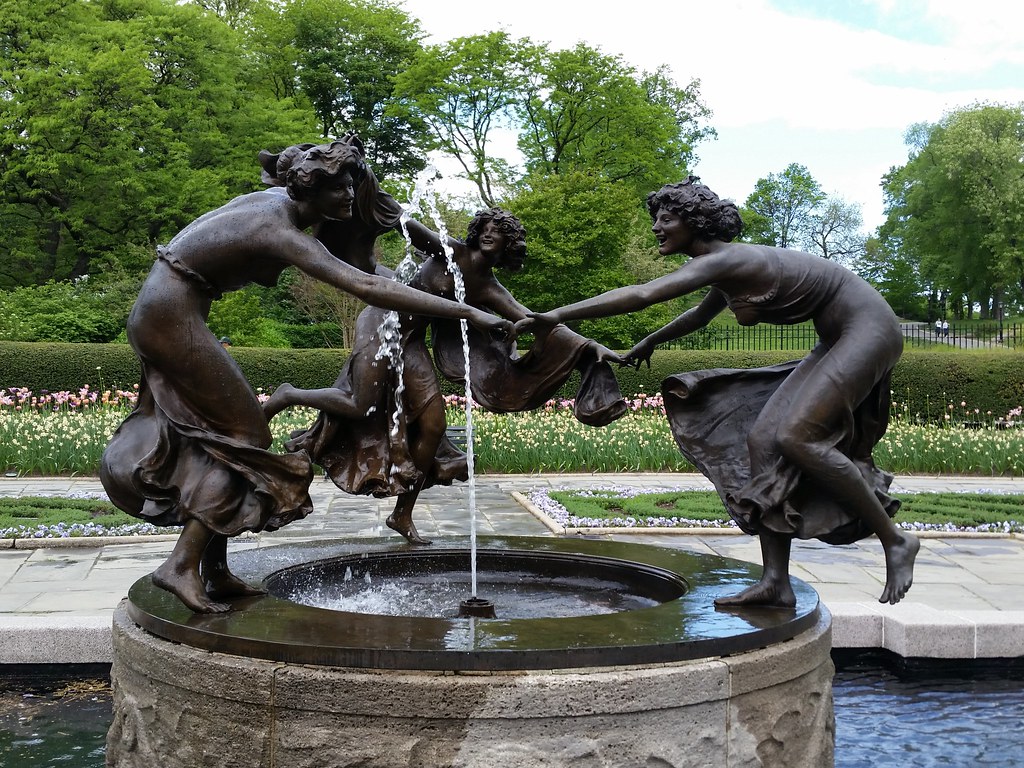
This is the Untermyer* Fountain in Central Park's Conservatory Garden. The sculpture was previously located at Greystone, Samuel Untermyer's former estate in Yonkers, 43 acres of which have been maintained, "somewhat haphazardly", by the City of Yonkers as Untermyer Park and Gardens, a part-spectacular, part-overgrown-and-dilapidated public park.
* We saw the Untermyer monument at Woodlawn Cemetery back in 2013.

